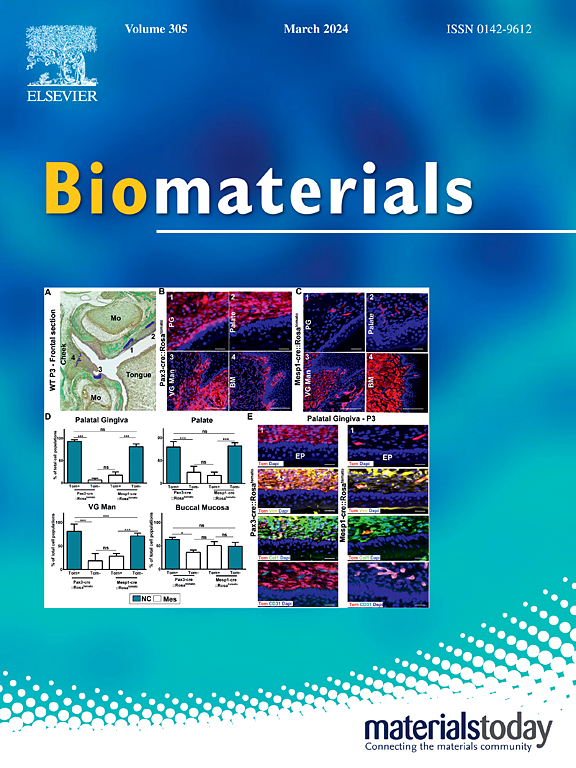Reprogrammed glycolysis-induced augmentation of NIR-II excited photodynamic/photothermal therapy
IF 12.8
1区 医学
Q1 ENGINEERING, BIOMEDICAL
引用次数: 0
Abstract
Small molecule-based multifunctional optical diagnostic materials have garnered considerable interest due to their highly customizable structures, tunable excited-state properties, and remarkable biocompatibility. We herein report the synthesis of a multifaceted photosensitizer, PPQ-CTPA, which exhibits exceptional efficacy in generating Type I reactive oxygen species (ROS) and thermal energy under near-infrared-II (NIR-II, >1000 nm) laser excitation at 1064 nm, thereby combining photodynamic therapy (PDT) and photothermal therapy (PTT) functionalities. To enhance therapeutic efficacy, we engineered lonidamine (LND) by conjugating it with triphenylphosphonium (TPP) cations, producing LND-TPP. This compound inhibits mitochondrial glycolysis and downregulates heat shock protein 90 (HSP 90) levels in a breast cancer mouse model, potentiating both PDT and PTT. For in vivo applications, PPQ-CTPA and LND-TPP are encapsulated within the amphiphilic polymer DSPE–SS–PEG to obtain PPQ-CTPAL NPs. In breast cancer cell lines, PPQ-CTPAL NPs are decomposed by cellular GSH, simultaneously releasing the dual-functioning photosensitizer PPQ-CTPL and the mitochondria-disrupting agent LND-TPP. Upon 1064 nm laser irradiation, we found that tumor growth in breast cancer mice is effectively restrained by PPQ-CTPAL NPs. This work highlights the synergistic integration of PDT, PTT, and chemotherapy facilitated by NIR-II fluorescence, photoacoustic, and photothermal imaging under 1064 nm irradiation, underscoring the clinical potential of multifunctional phototherapeutic agents.
重编程糖酵解诱导的NIR-II增强激发光动力/光热疗法
基于小分子的多功能光学诊断材料由于其高度可定制的结构、可调节的激发态特性和显著的生物相容性而获得了相当大的兴趣。本文报道了一种多面光敏剂PPQ-CTPA的合成,该光敏剂在1064 nm的近红外ii (NIR-II, >1000 nm)激光激发下产生I型活性氧(ROS)和热能,从而结合了光动力治疗(PDT)和光热治疗(PTT)功能。为了提高治疗效果,我们将lonidamine (LND)与triphenylphosphonium (TPP)阳离子偶联,制备了LND-TPP。在乳腺癌小鼠模型中,该化合物抑制线粒体糖酵解并下调热休克蛋白90 (HSP 90)水平,从而增强PDT和PTT。在体内应用中,PPQ-CTPA和LND-TPP被封装在两亲性聚合物DSPE-SS-PEG中,以获得PPQ-CTPAL NPs。在乳腺癌细胞系中,PPQ-CTPAL NPs被细胞GSH分解,同时释放出双功能光敏剂PPQ-CTPL和线粒体破坏剂LND-TPP。在1064 nm激光照射下,我们发现PPQ-CTPAL NPs能有效抑制乳腺癌小鼠的肿瘤生长。这项工作强调了NIR-II荧光、光声和光热成像在1064 nm照射下促进PDT、PTT和化疗的协同整合,强调了多功能光治疗剂的临床潜力。
本文章由计算机程序翻译,如有差异,请以英文原文为准。
求助全文
约1分钟内获得全文
求助全文
来源期刊

Biomaterials
工程技术-材料科学:生物材料
CiteScore
26.00
自引率
2.90%
发文量
565
审稿时长
46 days
期刊介绍:
Biomaterials is an international journal covering the science and clinical application of biomaterials. A biomaterial is now defined as a substance that has been engineered to take a form which, alone or as part of a complex system, is used to direct, by control of interactions with components of living systems, the course of any therapeutic or diagnostic procedure. It is the aim of the journal to provide a peer-reviewed forum for the publication of original papers and authoritative review and opinion papers dealing with the most important issues facing the use of biomaterials in clinical practice. The scope of the journal covers the wide range of physical, biological and chemical sciences that underpin the design of biomaterials and the clinical disciplines in which they are used. These sciences include polymer synthesis and characterization, drug and gene vector design, the biology of the host response, immunology and toxicology and self assembly at the nanoscale. Clinical applications include the therapies of medical technology and regenerative medicine in all clinical disciplines, and diagnostic systems that reply on innovative contrast and sensing agents. The journal is relevant to areas such as cancer diagnosis and therapy, implantable devices, drug delivery systems, gene vectors, bionanotechnology and tissue engineering.
 求助内容:
求助内容: 应助结果提醒方式:
应助结果提醒方式:


